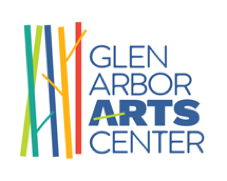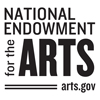
Creativity Q+A with Larry Fox
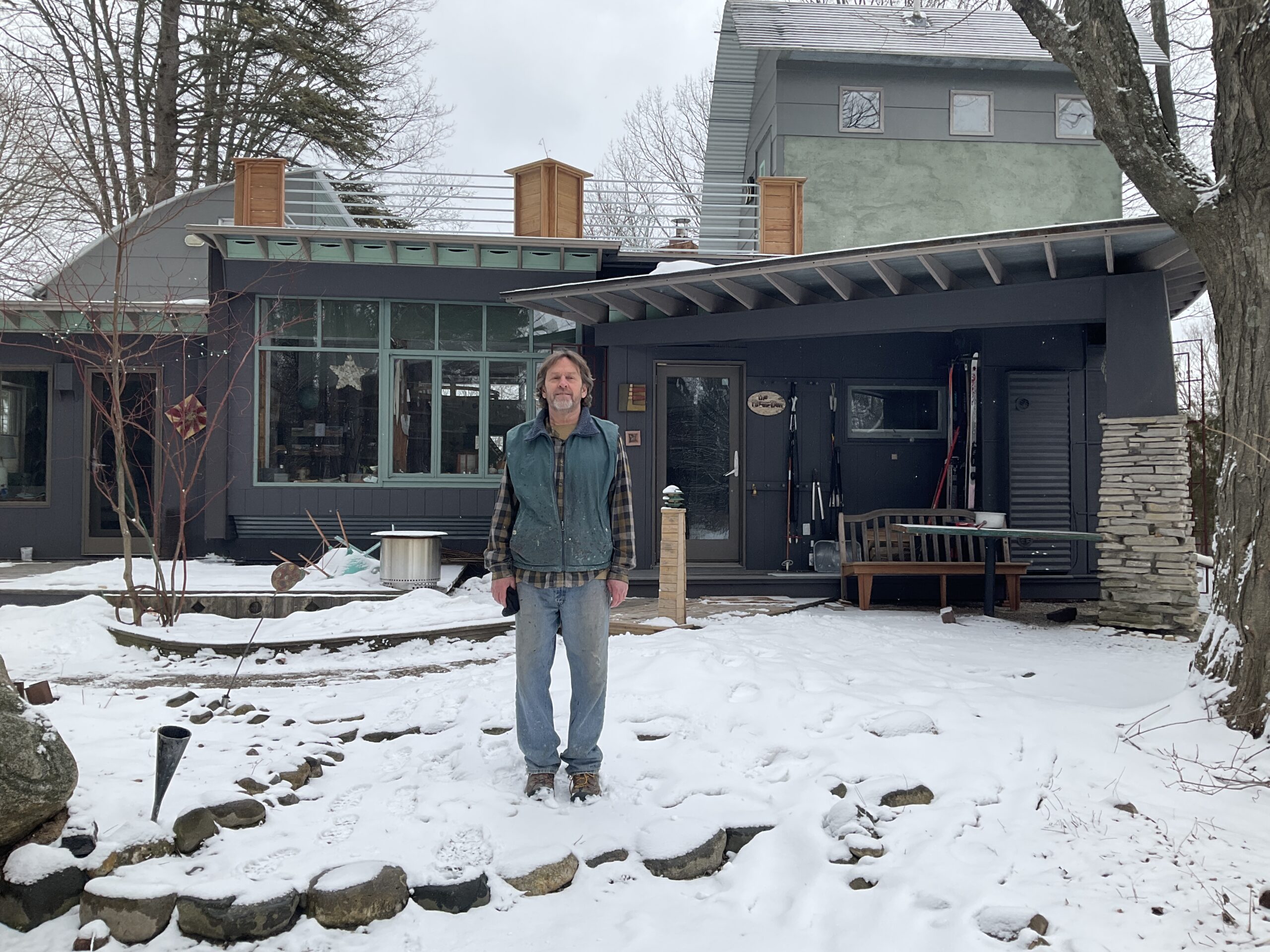
“I’ve always built things. I’ve been a maker since I was a little kid,” said Leelanau County artist Larry Fox, 69. And the things he has built — sculptural constructions in Poplar and Baltic Birch — have found their way into homes and corporate settings across the US. A veteran of the art fair circuit, Fox has traveled far and wide with his trailer full of work inspired by architectural shapes, cracks in the parking lot pavement, and what he discovers when he falls into a creative pothole. Fox’s work is all about dimensional shape. “I’m attracted to dimension,” he said. And it was dimension that brought him and his family to Northern MIchigan in 1989.
This interview was conducted in February 2023 by Sarah Bearup-Neal, GAAC Gallery Manager, and edited for clarity.
Pictured left: Larry Fox
You work in a sculptural form using wood.
Yes. Three-dimensional forms that are constructed out of wood, and primarily painted — as the finish.
And there are always lots of interesting marks on the surfaces of your sculptures.
A lot of that is a painting technique called dry brushing. I learned that from working on movie sets. It’s a loose type of painting. I also use colored pencils to enhance [the surface design] a little bit.
When did you work on movie sets, and where?
Mostly in Detroit. Small independents. Then I worked on a few big features around the country [including The Abyss, Tiger Town, and Stardust]. I was doing fine woodworking at the time — making furniture and building additions. This was in the 80s and 90s.
What draws you to working in wood , and working with wood in a sculptural way?
I can manipulate wood to satisfy my curiosity. My father had a shop, and as a young kid I was in the shop all the time. He was very giving about me playing around in there. That’s where [his interest in] wood came from — and the fact that it’s a natural material — as opposed to metal. I don’t find other materials attractive. Wood is warm. It’s growing. I love trees. The three-dimensional aspect: I’ve always been attracted to dimension. I grew up in Detroit, and it was totally flat. That’s one reason why I’m in Leelanau County: There’s some dimension to [the landscape]. I’ve been thinking about transitioning to painting as I get older, and I haven’t made that leap yet — because of the dimensional aspect …
It’s flat.
It’s flat!
What physical effects are you feeling that makes you consider leaping ship, and going to painting?
Getting out of bed every day. My body’s starting to hurt. I used to do a lot of really-big work [e.g. a 50 foot-long installation for GE Medical, Milwaukee, Wisconsin, in 2006]. I’ve curtailed that. I’m doing more bench work. I still have the desire [to work large], but not the energy.
Did your dad let you run power tools?
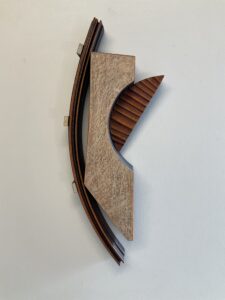
Oh, yeah. I was lucky I never did anything really bad. I would always take the tools, and try to push them: What can I do with this as opposed to just doing what you’re supposed to do? I would always push. I do that with my work.
You don’t allow yourself to be hemmed in by either the materials or the tools, or the conventional expectations of what both of those things can do.
To a degree, I do. You have to respect the materials and the tools. Every time you approach a power tool you have to be on your game. I appreciate that aspect of it. At the same time, the other side of my brain is going, What can you do with this that’s different?
Did you receive any formal training in visual art?
I studied architecture for two years at Lawrence Tech. And then I went to the College For Creative Studies in industrial design. And then I got a degree from Wayne State in art education [1979]. I also went to Penland, and Haystack, which are craft schools. And an internship out in Canada at the Banff Art Center.
How did your formal training affect your development as a creative practitioner?
It definitely contributed to my ability to use my talents.
It sounds like you may have learned a lot in the doing.
Yes. I would say mostly in the doing.
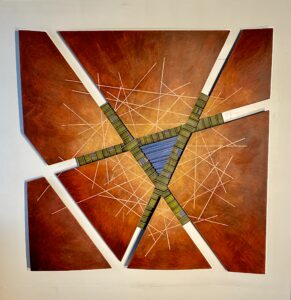
Describe your studio/work space.
It’s in a pole barn, and is a 24 feet by 24 feet. I have a room for painting and drawing. It’s 150 feet from my house. Half of it’s heated. When I first moved in, it did not have windows. I remember coming back from a funeral [25 years ago], and I said, I’ve got to put a window in that shop. So, I got a big window from somebody who was ripping down a big house. It overlooks all these pine trees, and it’s beautiful.
How does your studio/work space facilitate your work?
I’ve had six or seven studios in my life, everything from a garage to a studio in Suttons Bay [Michigan]. It can make it easier; but the actual work? It really doesn’t matter. You’ve got to have natural light. You’ve got to be relatively comfortable. But you can adapt to anything.
What themes/ideas are the focus of your work?
A primary idea is one based on observation, [observing] form, pattern. If I see something — let’s say it’s a crack in the sidewalk, and I’ll say, That’s amazing. I’ll eventually interpret that [observation] into a piece. Sometimes I’ll want to tell a story, whether it’s political or human relations. There’s an architectural interest. I get ideas walking in the woods. There’s natural phenomena. There’s man-made phenomena. Pretty much everything.
It’s like you’re always punched in.
You are. It’s amazing. The key is, as soon as you see something, you’ve got to jot it down. You’ve got to sketch it on a piece of paper or wood. Then you put it away, and say, Someday I’ll make that.
I’m interested that you jot down inspirations. Cameras are ever present these days. Are you still a pencil-and-paper guy?
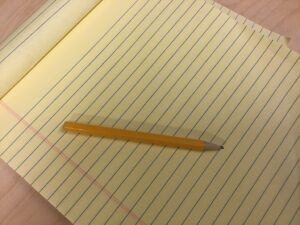
Oh yeah. Give me a legal pad and a Sharpie, and I’m happy. The pencil issue: I’ve always loved drawing. Even now, I don’t spend a lot of time drawing; but I do sketch out my work. Loosely. I’ve always loved that physicality of the pencil on the paper, and that texture of the paper is important. There’s a great joy to sit down and just draw some ideas down: That’s one of my favorite things to do.
What prompts the beginning of a project or composition?
First you have to have the idea, the concept [and ask yourself] How am I going to interpret that concept in a physical form? You have to ask yourself what you want to say. What is this piece about? Is this a form piece? Or does it mean something? What is it? You take that thought pattern, and interpret into the shapes. I draw the piece as I build it. I see the piece graphically as I’m making it. And, sometimes I build and see that it’s not working, so I cut it in half, and now it works: You can’t always see it right away.
You work in wood. It takes a little courage to chop things up. Wood is a lot harder to put back together than a couple pieces of paper or fabric.
Not really. There is a little bit of a [psychologic] barrier. You try to talk yourself into [settling for a composition that doesn’t work by saying]: That’s OK. That looks pretty good. But you keep coming back to: That’s not OK. And so you go: I gotta do it. But you don’t want to do it because you’ve already put the time and effort into building it, and you know it’s not right.
Sometimes I see that as an opportunity to have a new creative thought. It ejects you from the path you were on, which is saying, You’re going in this direction. But then you hit a pothole.
And, sometimes, those potholes are fantastic. They make the piece. Sometimes your initial concept of the piece doesn’t quite work. It’s always about: How am I going to make this piece work? It’s not a black and white thing.
Do you work on more than one project at a time?
Rarely. I can’t multitask very well — unless it’s a process I have to let sit, and then I’ll go onto something else.
What’s your favorite tool?
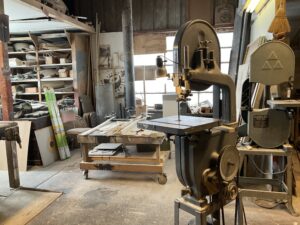
Bandsaw.
Why’s that?
The freedom of it.
It’s a scary tool, with a band of sharp, fast-moving metal.
You always have to have your hands away from the blade. What that tool can do is incredible. It’s a blade and you can play with it. A lot of things I work on aren’t perfectly straight. There was time when that was different, but now my work is a lot looser.
Why is making things by hand important to you?
It’s key. Every time you make something, you’re creating something — whether it’s a chair or a table or a house. You had this idea, and you process it, and you make the thing. It’s an over-and-over cycle of burden. Here’s this new thing. It’s incredible.
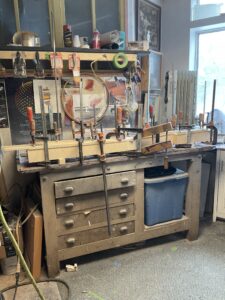
Why does making by-hand remain valuable and vital to modern life?
From the beginning of time, it’s a human thing to use your hands — whether you’re gathering food, or you’re making a piece of art. I think a lot of people lose it, forget about it. But I think every human has that desire to make things.
When did you commit to working with serious intent?
I did my student teaching, and I thought, I like making things better than teaching. As far as committing to it, after college I thought about being a self-employed woodworker. There was no [precipitating] event, but I had to make money, so I was going to do what I loved to do. I always dabbled in other things — film, film sets — but the other side of that, I was always making something — whether it was with 20 people or by myself.
What role does social media play in your practice?
A website is the beginning of that. You have to have a website. The website connects people with your work that would never see it, and is a reference once they have an interest in it. Other than that, if I’m doing a show, my social media director — who is my daughter [Lindsey, 31, also a visual artist] — she does all the [social media promotional] stuff on Instagram.
Do you use social media to tell the world about your work, or look for inspiration?
No. I try to stay off it. I have to admit that I’m as curious as the next person, and sometimes you see stuff that’s really cool. But I don’t like going there.
What do you believe is the visual artist’s role in the world?
People who make things, artists, they can show me things I might not even think of. [They] broaden your view of the world, and [they] open up a bigger picture.
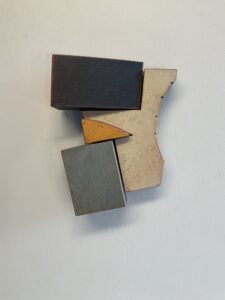
How does living in Northern Michigan inform and influence your creative practice?
Living up here allows me to have a lot of time to pursue the work I want to do, uninterrupted, and a low-key, very low-key, lifestyle. It [allows him] to clear my head, and have a clean palette to work with. Lots of times, you end up living where you went on vacation as a kid. I came up north on vacation when I was a kid. I grew up in Detroit, so I also have a big-city fix I have to satisfy every so often. When I did more [art fairs] I used to get that satisfied. Now, [his life] is a little isolated as I get older. It’s very quiet up here in the winter. I gotta get out more.
You’ve shown your work on the air fair circuit for decades. What kind of job is that for a guy to have?
The beauty of that whole [art fair] world is it allows you to do what you love to do. Now, traveling to the shows and selling the work — I’ve never liked that. I’m introverted. I have to get into my extrovert mode to do that. As a general thing, it’s not my favorite part of the business.
You get a lot of immediate feedback about your work on the air fair circuit. You come face-to-face with a lot of human beings who are looking at your work.
You have to put on your sales-person hat, and it’s really important what you say and how you present yourself. I can do it occasionally. I like the idea that the work sells itself, but that’s not really true: You have to engage and say the right thing. That’s the part of the business I’m not really crazy about. I’ve struggled with it. I’ve been [working the art fair circuit] for about 30 years now.
Do you exhibit at art fairs year-round? Do you do that trek to Florida to do all the shows in that state?
I used to do it every year, but I’m kind-of done with Florida. I did that for 20 years.
When you were growing up, did you know anyone with a serious, creative practice?
My dad loved making things, but everything was by-the-book. My mom was a Sunday painter. Most people asked me, What are you doing? You can’t be an artist. When are you going to get a real job. I heard that a lot.
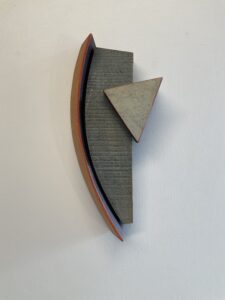
Who has had the greatest and most lasting influence on your work?
My heroes, in the historical sense, are Frank Lloyd Wright, Louise Nevelson, the Spanish architect Santiago Calatrava.
To whom do you go when you need honest feedback about your work?
At this point, my daughter, Martha [his wife], and my son Jesse [27]. He’s really good with proportion and forms.
What is the role of exhibiting in your practice? Do you ever exhibit your work in museum or gallery shows?
Yes. It’s getting eyes on your work.
Tell me how you fuel and nurture your creativity.
I do it by taking hikes, going skiing, reading.
Walking in parking lots looking for cracks in the pavement?
Exactly. I don’t directly try to nurture my creativity. I’ve never had to. It’s hard to answer that. You go through hills and valleys of creativity. Sometimes, when I’m in a valley, I go, I haven’t really thought of any good ideas in the last month. But I don’t go, I’ve gotta do something to nurture it. All of a sudden, there will be another wave. I can’t tell you what promotes that.
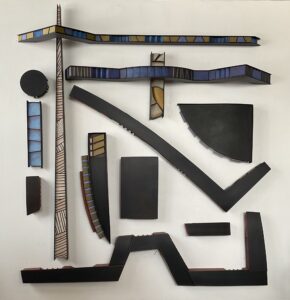
You work, mostly, in a non-representational fashion. Why is that the best way for you to execute ideas — as opposed to trying to make something that someone will say, A-ha! That’s a chair!
Whenever I was in drawing class, there were compositions or human forms, and you’re supposed to capture that — the proportions, the feelings. When I make stuff, I don’t want to be tied to [its realism]: That’s a horse, or that’s a hill. I just want to make an interpretation of [an object or subject]. It frees you up. It’s partially due to my limited technical abilities — that’s why I switched from fine woodworking to what I do now. Technically, it’s not that challenging, but artistically, it’s more challenging. It’s a lot more fun. Harder to sell, but it’s a lot more fun.
Read more about Larry Fox here.
Sarah Bearup-Neal develops and curates Glen Arbor Arts Center exhibitions. She maintains a studio practice focused on fiber and collage.
